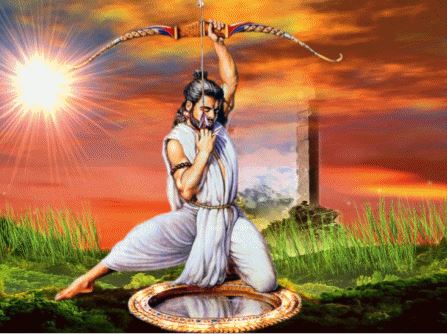The story therefore exists also at a symbolic and psychological level. But this is not the usual psychology that we are accustomed to read today. These ‘spiritual psychologists’ or yogis so to say, who wrote these enduring epics were not satisfied with superficial explanations of human behavior nor contended with simply erecting a theoretical construct around human life. We often see these constructs and theories, alas often built by studying pathological human behavior. But even those that study ‘normal’ human behavior are content with studying it on the surface rather than diving deep within it to discover new possibilities and hidden capacities of nature. To put it briefly, while much of modern psychology tends to be a projection and derivative of the subnormal and the abnormal, the ancient wisdom derived its truths from the super-normal and the a-normal so to say. The physical story becomes a nucleus, a pedestal for the author to launch into a depiction of human nature in all its varieties and shades. That is how the epics become universal in their quality and contemporary in their appeal.
 The characters we find in the Ramayana and the Mahabharata, for that matter in the Iliad and the Odyssey are archetypes that continue to exist within us and drive us towards the heights and push us towards the abysses of human nature. But this psychology, in the Indian setting was also a means of cultural transmission, that is to say a means to inspire generations to come with the highest thoughts and possibilities of mankind. It had little to do with outer customs and dress and other paraphernalia which was adapted to those times and much more to do with the thoughts and feelings and actions of a group of humanity. The myths became a means to portray and present before man a living Ideal which can become a force multiplier much more than any mere abstract idealism can do. We should be like Rama in strength and courage, like Bhishma in will and statesmanship, like Arjuna in skill and power of concentration, like Karna in generosity, like Abhimanyu in sacrifice and so on and so forth. There are female personalities too who place before us the ideal feminine. Draupadi the powerful empress who brought down an empire to uphold the dignity of a woman, Sita the long suffering yet forgiving, patient and gentle, a warrior in outer as well as inner life. Savitri, steadfast in love and wisdom, who by the strength of her tapasya took on Death himself as her opponent and won the game of life against him. We need these characters to inspire us even today. They are greatness personified.
The characters we find in the Ramayana and the Mahabharata, for that matter in the Iliad and the Odyssey are archetypes that continue to exist within us and drive us towards the heights and push us towards the abysses of human nature. But this psychology, in the Indian setting was also a means of cultural transmission, that is to say a means to inspire generations to come with the highest thoughts and possibilities of mankind. It had little to do with outer customs and dress and other paraphernalia which was adapted to those times and much more to do with the thoughts and feelings and actions of a group of humanity. The myths became a means to portray and present before man a living Ideal which can become a force multiplier much more than any mere abstract idealism can do. We should be like Rama in strength and courage, like Bhishma in will and statesmanship, like Arjuna in skill and power of concentration, like Karna in generosity, like Abhimanyu in sacrifice and so on and so forth. There are female personalities too who place before us the ideal feminine. Draupadi the powerful empress who brought down an empire to uphold the dignity of a woman, Sita the long suffering yet forgiving, patient and gentle, a warrior in outer as well as inner life. Savitri, steadfast in love and wisdom, who by the strength of her tapasya took on Death himself as her opponent and won the game of life against him. We need these characters to inspire us even today. They are greatness personified.
It may be mentioned here that Indians loved greatness and revered it wherever it was found. The Arya, the Srestha, the noble is their Ideal. This way they helped generations after generations nourished by the sap of idealism and the spirit of sacrifice. It is only when burdened under the reign of alien rulers and with the creeping in of escapist philosophies and extreme practices such as asceticism that we fail from the Ideal but the memory of it is still preserved and continues to haunt us even in popular culture and awaits its hour of revival. This revival cannot be by vigilantes and self-proclaimed Hindus but by those who live the truth of the Vedas and the Gita, who realize the deep teachings of the Upanishads and put it into their daily thoughts and feelings and actions. Not mechanical custom and ritual but spiritual awakening, not religion and philosophy but living straight from the deeper intuitive heart is what is most needed. And if we do that, we shall find the secret code of the myth unlocked before us and the script self-revealed in the light of a growing intuition and illumination.



